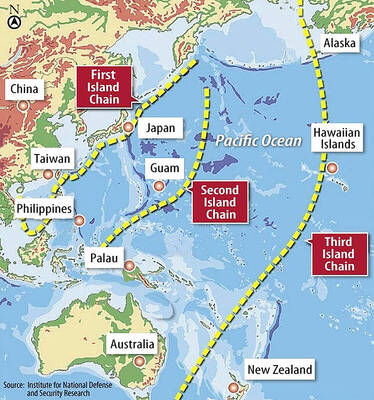A drunken Chinese tourist bit a panda at the Beijing Zoo after the animal attacked him when he jumped into the enclosure and tried to hug it, state media said yesterday.
Zhang Xinyan had drunk four pitchers of beer at a restaurant before "stumbling to the zoo" nearby and stopping off at the pen holding a sleeping six-year-old male panda, Gu Gu, on Tuesday, the Beijing Morning Post said.
"He felt a sudden urge to touch the panda with his hand" and jumped over a waist-high railing down into the enclosure, the newspaper said. "When he got closer and was undiscovered, he reached out to hug it."
Startled, Gu Gu bit Zhang in the right leg, it said. Zhang, a 35-year-old migrant laborer from central Henan province, became angry and kicked the panda, who then bit his other leg. A tussle ensued, the paper said.
"I bit the fellow in the back," Zhang was quoted as saying in the newspaper. "Its skin was quite thick."
Other tourists yelled for a zookeeper, who soon had the panda under control by spraying it with water, reports said. Zhang was hospitalized.
Newspaper photos showed Zhang lying on a hospital bed with blood-soaked bandages and several seams of stitches running down his leg.
The Beijing Youth Daily quoted Zhang, a father of two who was visiting Beijing for the first time, as saying that he had seen pandas on television and "they seemed to get along well with people."
"No one ever said they would bite people," Zhang said. "I just wanted to touch it. I was so dizzy from the beer. I don't remember much."
Ye Mingxia, a spokeswoman for the Beijing Zoo, confirmed the incident happened but would not give any details. She said Gu Gu was "healthy and uninjured."
"We're not considering punishing him now," Ye said in a telephone interview. "He's suffered quite a bit of shock."
China has more than 180 pandas living in captivity. A 2002 government census found there were just 1,596 pandas left in the wild.
But state media has said a new study by Chinese and British scientists found there might be as many as 3,000.
In 2003, a college student trying to take a photo of a panda in the Beijing Zoo jumped into the enclosure and broke his bones in the fall, the Beijing Morning Post said.
It did not say which panda it was or if it attacked the student.

LIMITS: While China increases military pressure on Taiwan and expands its use of cognitive warfare, it is unwilling to target tech supply chains, the report said US and Taiwan military officials have warned that the Chinese People’s Liberation Army (PLA) could implement a blockade within “a matter of hours” and need only “minimal conversion time” prior to an attack on Taiwan, a report released on Tuesday by the US Senate’s China Economic and Security Review Commission said. “While there is no indication that China is planning an imminent attack, the United States and its allies and partners can no longer assume that a Taiwan contingency is a distant possibility for which they would have ample time to prepare,” it said. The commission made the comments in its annual

DETERMINATION: Beijing’s actions toward Tokyo have drawn international attention, but would likely bolster regional coordination and defense networks, the report said Japanese Prime Minister Sanae Takaichi’s administration is likely to prioritize security reforms and deterrence in the face of recent “hybrid” threats from China, the National Security Bureau (NSB) said. The bureau made the assessment in a written report to the Legislative Yuan ahead of an oral report and questions-and-answers session at the legislature’s Foreign Affairs and National Defense Committee tomorrow. The key points of Japan’s security reforms would be to reinforce security cooperation with the US, including enhancing defense deployment in the first island chain, pushing forward the integrated command and operations of the Japan Self-Defense Forces and US Forces Japan, as

IN THE NATIONAL INTEREST: Deputy Minister of Foreign Affairs Francois Wu said the strengthening of military facilities would help to maintain security in the Taiwan Strait Japanese Minister of Defense Shinjiro Koizumi, visiting a military base close to Taiwan, said plans to deploy missiles to the post would move forward as tensions smolder between Tokyo and Beijing. “The deployment can help lower the chance of an armed attack on our country,” Koizumi told reporters on Sunday as he wrapped up his first trip to the base on the southern Japanese island of Yonaguni. “The view that it will heighten regional tensions is not accurate.” Former Japanese minister of defense Gen Nakatani in January said that Tokyo wanted to base Type 03 Chu-SAM missiles on Yonaguni, but little progress

NO CHANGES: A Japanese spokesperson said that Tokyo remains consistent and open for dialogue, while Beijing has canceled diplomatic engagements A Japanese official blasted China’s claims that Japanese Prime Minister Sanae Takaichi has altered Japan’s position on a Taiwan crisis as “entirely baseless,” calling for more dialogue to stop ties between Asia’s top economies from spiraling. China vowed to take resolute self-defense against Japan if it “dared to intervene militarily in the Taiwan Strait” in a letter delivered Friday to the UN. “I’m aware of this letter,” said Maki Kobayashi, a senior Japanese government spokeswoman. “The claim our country has altered its position is entirely baseless,” she said on the sidelines of the G20 summit in Johannesburg on Saturday. The Chinese Ministry